Energy Efficient Routing and Dynamic Cluster Head Selection Using Enhanced Optimization Algorithms for Wireless Sensor Networks
Abstract
:1. Introduction
- For the low computational complexity and excellent stability, the ICOA is utilized in the WSN to choose the CH. Based on numerous objective values, ICOA selects the CH, such as node degree, residual energy, node centrality, distance to the BS, and distance to neighbors.
- In WSN, IT can enable the rapid discovery of solutions. By utilizing the IJLFA, the shortest route between CH and BS is discovered.
- Because of the optimal route generation and energy-efficient CH selection for the transmission of data, the network’s lifetime is extended. Furthermore, by reducing the energy utilization of nodes while transferring packets, the overall packets expected by the BS are enhanced.
2. Related Work
3. Dynamic CH Selection and Energy-Efficient Routing Design
3.1. Problem Statement
3.2. Network Model
- In terms of processing time and initial energy, the entire nodes are the same as every other in WSN.
- Depending on the Euclidean distance, the distance of the sensor is evaluated.
- The node’s position is constant after the deployment, and the nodes are casually positioned in the sensing situation.
- From the nodes, the BS obtains the distance and residual energy information. CHs are selected by an effective CH selection algorithm based on this information. Hence, the route among the CHs to the BS is obtained by the routing process.

3.3. Energy Model
3.4. Proposed Methodology
3.4.1. CH Selection Using ICOA
- (a)
- CH Residual energy
- (b)
- Distance among sensor nodes:
- (c)
- CH and BS Distance:
- (d)
- Node degree
- (e)
- Node centrality
3.4.2. Clusters Formulation Using the Potential Function
3.4.3. Routing Algorithm Using IJLFA
3.4.4. Cluster Maintenance
4. Results and Discussion
4.1. Performance Metrics
4.2. Simulation Setup
4.3. Performance Analysis
5. Conclusions
Author Contributions
Funding
Data Availability Statement
Conflicts of Interest
References
- SriVenkateswaran, C.; Sivakumar, D. Secure cluster-based data aggregation in wireless sensor networks with aid of ECC. Int. J. Bus. Inf. Syst. 2019, 31, 153–169. [Google Scholar] [CrossRef]
- Jun, Y.; Craig, A.; Shafik, W.; Sharif, L. Artificial Intelligence Application in Cybersecurity and Cyberdefense. Wirel. Commun. Mob. Comput. 2021, 2021, 3329581. [Google Scholar] [CrossRef]
- Lee, W.K.; Schubert, M.J.; Ooi, B.Y.; Ho, S.J.Q. Multi-source energy harvesting and storage for floating wireless sensor network nodes with long range communication capability. IEEE Trans. Ind. Appl. 2018, 54, 2606–2615. [Google Scholar] [CrossRef]
- Putra, S.A.; Trilaksono, B.R.; Riyansyah, M.; Laila, D.S.; Harsoyo, A.; Kistijantoro, A.I. Intelligent sensing in multiagent-based wireless sensor network for bridge condition monitoring system. IEEE Internet Things J. 2019, 6, 5397–5410. [Google Scholar] [CrossRef]
- Sharma, K.; Anand, D.; Sabharwal, M.; Tiwari, P.K.; Cheikhrouhou, O.; Frikha, T. A Disaster Management Framework Using Internet of Things-Based Interconnected Devices. Math. Probl. Eng. 2021, 2021, 9916440. [Google Scholar] [CrossRef]
- Sahu, S.; Silakari, S. Analysis of Energy, Coverage, and Fault Issues and their Impacts on Applications of Wireless Sensor Networks: A Concise Survey. Network 2021, 10, 13. [Google Scholar] [CrossRef]
- Shu, T.; Chen, J.; Bhargava, V.K.; de Silva, C.W. An energy-efficient dual prediction scheme using LMS filter and LSTM in wireless sensor networks for environment monitoring. IEEE Internet Things J. 2019, 6, 6736–6747. [Google Scholar] [CrossRef]
- El Khediri, S.; Fakhet, W.; Moulahi, T.; Khan, R.; Thaljaoui, A.; Kachouri, A. Improved node localization using K-means clustering for Wireless Sensor Networks. Comput. Sci. Rev. 2020, 37, 100284. [Google Scholar] [CrossRef]
- Su, S.; Zhao, S. A hierarchical hybrid of genetic algorithm and particle swarm optimization for distributed clustering in large-scale wireless sensor networks. J. Ambient. Intell. Humaniz. Comput. 2017, 1–11. [Google Scholar] [CrossRef]
- Sangeetha, M.; Sabari, A. Genetic optimization of hybrid clustering algorithm in mobile wireless sensor networks. Sens. Rev. 2018, 38, 526–533. [Google Scholar]
- Sennan, S.; Ramasubbareddy, S.; Balasubramaniyam, S.; Nayyar, A.; Kerrache, C.A.; Bilal, M. MADCR: Mobility aware dynamic clustering-based routing protocol in Internet of Vehicles. China Commun. 2021, 18, 69–85. [Google Scholar] [CrossRef]
- Qureshi, K.N.; Tayyab, M.Q.; Rehman, S.U.; Jeon, G. An interference aware energy efficient data transmission approach for smart cities healthcare systems. Sustain. Cities Soc. 2020, 62, 102392. [Google Scholar] [CrossRef]
- Arjunan, S.; Sujatha, P. Lifetime maximization of wireless sensor network using fuzzy based unequal clustering and ACO based routing hybrid protocol. Appl. Intell. 2018, 48, 2229–2246. [Google Scholar] [CrossRef]
- Abualigah, L.M.; Khader, A.T.; Hanandeh, E.S.; Gandomi, A.H. A novel hybridization strategy for krill herd algorithm applied to clustering techniques. Appl. Soft Comput. 2017, 60, 423–435. [Google Scholar] [CrossRef]
- Sayed, G.I.; Khoriba, G.; Haggag, M.H. A novel chaotic salp swarm algorithm for global optimization and feature selection. Appl. Intell. 2018, 48, 3462–3481. [Google Scholar] [CrossRef]
- Venkateswarulu, B.; Subbu, N.; Ramamurthy, S. An efficient routing protocol based on polar tracing function for underwater wireless sensor networks for mobility health monitoring system application. J. Med. Syst. 2019, 43, 218. [Google Scholar] [CrossRef] [PubMed]
- Jiang, B.; Huang, G.; Wang, T.; Gui, J.; Zhu, X. Trust based energy efficient data collection with unmanned aerial vehicle in edge network. Trans. Emerg. Telecommun. Technol. 2020, 33, e3942. [Google Scholar] [CrossRef]
- Yuvaraj, D.; Sivaram, M.; Ahamed, A.M.U.; Nageswari, S. An efficient lion optimization based cluster formation and energy management in WSN based IoT. In Proceedings of the International Conference on Intelligent Computing & Optimization, Chongqing, China, 6–8 December 2019; Springer: Cham, Switzerland, 2019; pp. 591–607. [Google Scholar]
- Cui, Z.; Cao, Y.; Cai, X.; Cai, J.; Chen, J. Optimal LEACH protocol with modified bat algorithm for big data sensing systems in Internet of Things. J. Parallel Distrib. Comput. 2019, 132, 217–229. [Google Scholar] [CrossRef]
- Moussa, N.; El Alaoui, A.E.B. An energy-efficient cluster-based routing protocol using unequal clustering and improved ACO techniques for WSNs. Peer-to-Peer Netw. Appl. 2021, 14, 1334–1347. [Google Scholar] [CrossRef]
- Sankar, S.; Ramasubbareddy, S.; Chen, F.; Gandomi, A.H. Energy-Efficient Cluster-Based Routing Protocol in Internet of Things Using Swarm Intelligence. In Proceedings of the 2020 IEEE Symposium Series on Computational Intelligence (SSCI), Canberra, ACT, Australia, 1–4 December 2020; IEEE: Manhattan, NY, USA, 2020; pp. 219–224. [Google Scholar]
- Loganathan, G.B.; Salih, I.H.; Karthikayen, A.; Kumar, N.S.; Durairaj, U. EERP: Intelligent Cluster based Energy Enhanced Routing Protocol Design over Wireless Sensor Network Environment. Int. J. Mod. Agric. 2021, 10, 1725–1736. [Google Scholar]
- Yong, J.; Lin, Z.; Qian, W.; Ke, B.; Chen, W.; Ji-fang, L. Tree-Based Multihop Routing Method for Energy Efficiency of Wireless Sensor Networks. J. Sens. 2021, 2021, 6671978. [Google Scholar] [CrossRef]
- Maheshwari, P.; Sharma, A.K.; Verma, K. Energy efficient cluster based routing protocol for WSN using butterfly optimization algorithm and ant colony optimization. Ad Hoc Netw. 2021, 110, 102317. [Google Scholar] [CrossRef]
- Sampathkumar, A.; Murugan, S.; Rastogi, R.; Mishra, M.K.; Malathy, S.; Manikandan, R. Energy Efficient ACPI and JEHDO Mechanism for IoT Device Energy Management in Healthcare. In Internet of Things in Smart Technologies for Sustainable Urban Development; Kanagachidambaresan, G.R., Maheswar, R., Manikandan, V., Ramakrishnan, K., Eds.; EAI/Springer Innovations in Communication and Computing; Springer: Cham, Switzerland, 2020. [Google Scholar] [CrossRef]
- Sampathkumar, A.; Mulerikkal, J.; Sivaram, M. Glowworm swarm optimization for effectual load balancing and routing strategies in wireless sensor networks. Wirel. Netw. 2020, 26, 4227–4238. [Google Scholar] [CrossRef]
- Sampathkumar, A.; Murugan, S.; Sivaram, M.; Sharma, V.; Venkatachalam, K.; Kalimuthu, M. Advanced Energy Management System for Smart City Application Using the IoT. In Internet of Things in Smart Technologies for Sustainable Urban Development; Kanagachidambaresan, G.R., Maheswar, R., Manikandan, V., Ramakrishnan, K., Eds.; EAI/Springer Innovations in Communication and Computing; Springer: Cham, Switzerland, 2020. [Google Scholar] [CrossRef]
- Kotiyal, V.; Singh, A.; Sharma, S.; Nagar, J.; Lee, C.-C. ECS-NL: An Enhanced Cuckoo Search Algorithm for Node Localisation in Wireless Sensor Networks. Sensors 2021, 21, 3576. [Google Scholar] [CrossRef] [PubMed]
- Bacanin, N.; Antonijevic, M.; Bezdan, T.; Zivkovic, M.; Rashid, T.A. Wireless Sensor Networks Localization by Improved Whale Optimization Algorithm. In Proceedings of 2nd International Conference on Artificial Intelligence: Advances and Applications; Mathur, G., Bundele, M., Lalwani, M., Paprzycki, M., Eds.; Algorithms for Intelligent Systems; Springer: Singapore, 2022. [Google Scholar] [CrossRef]
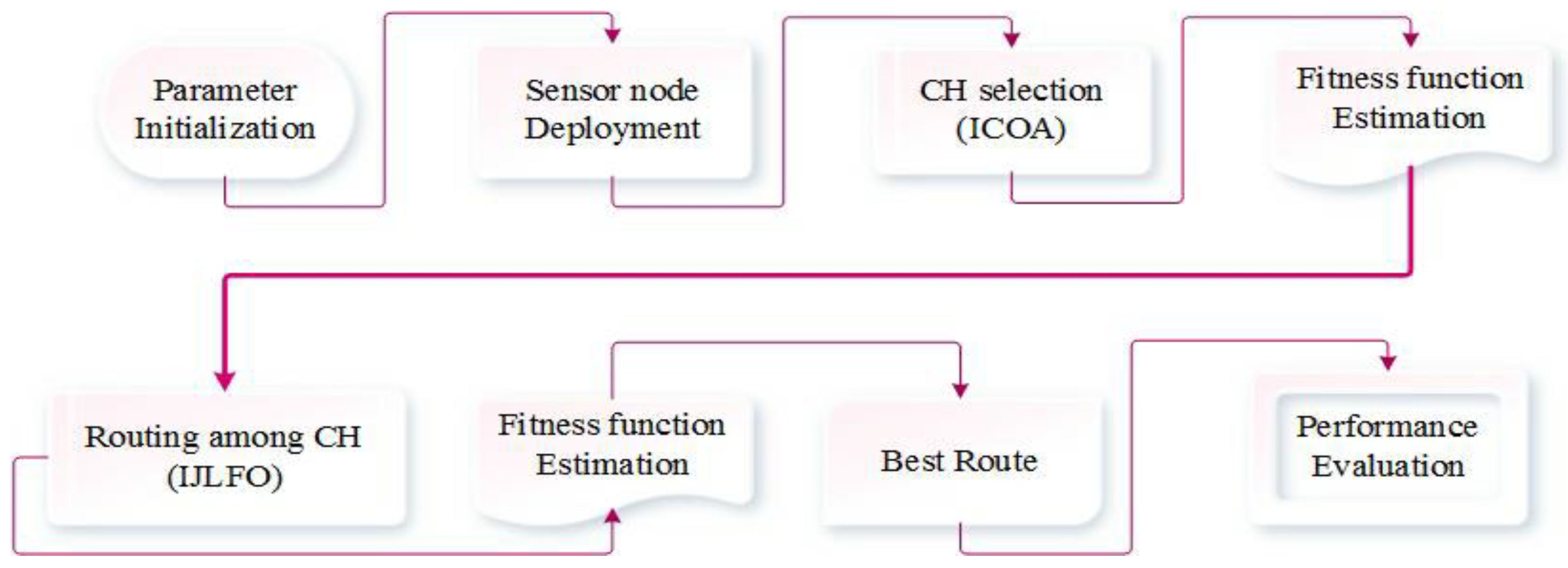
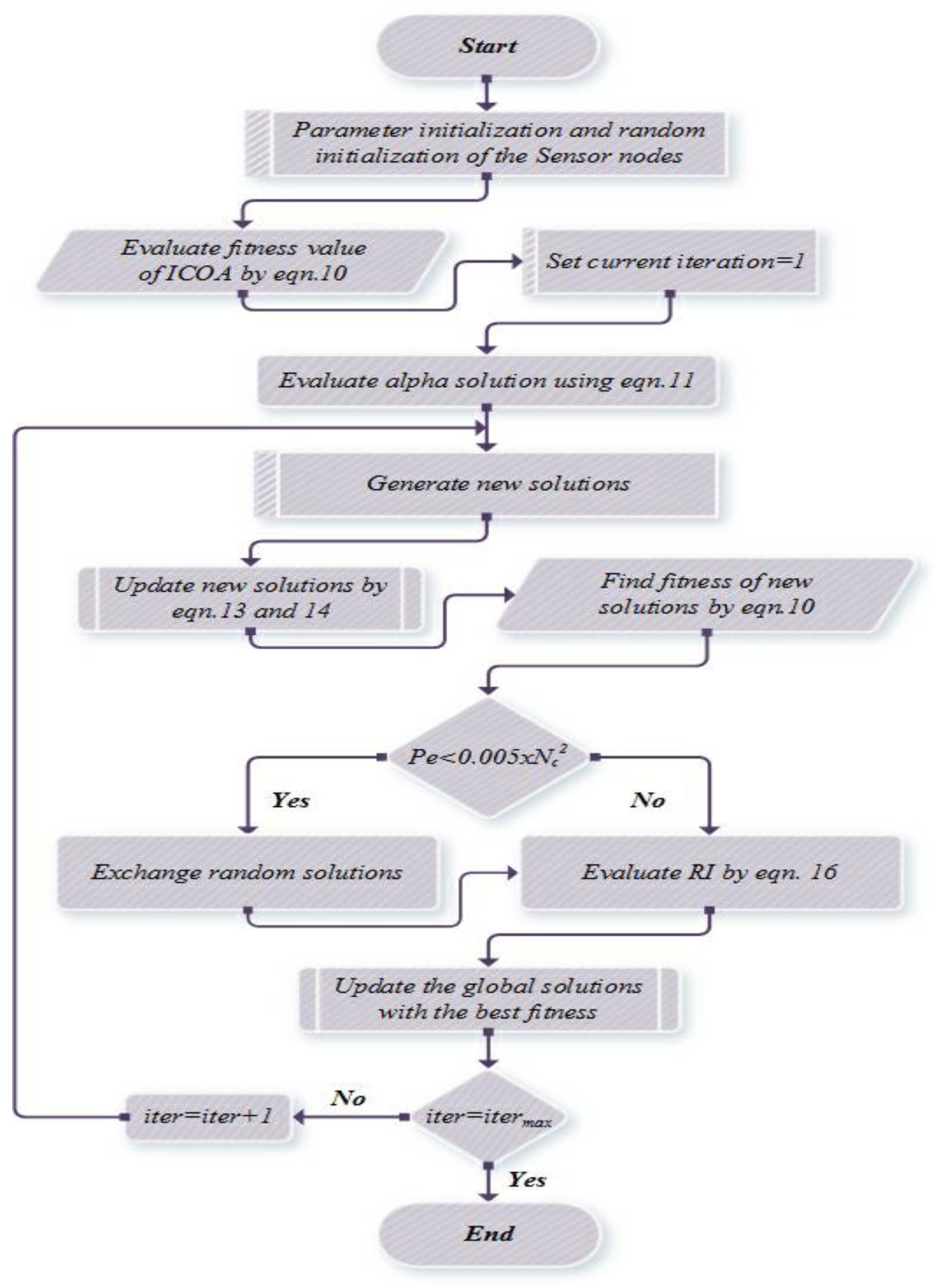

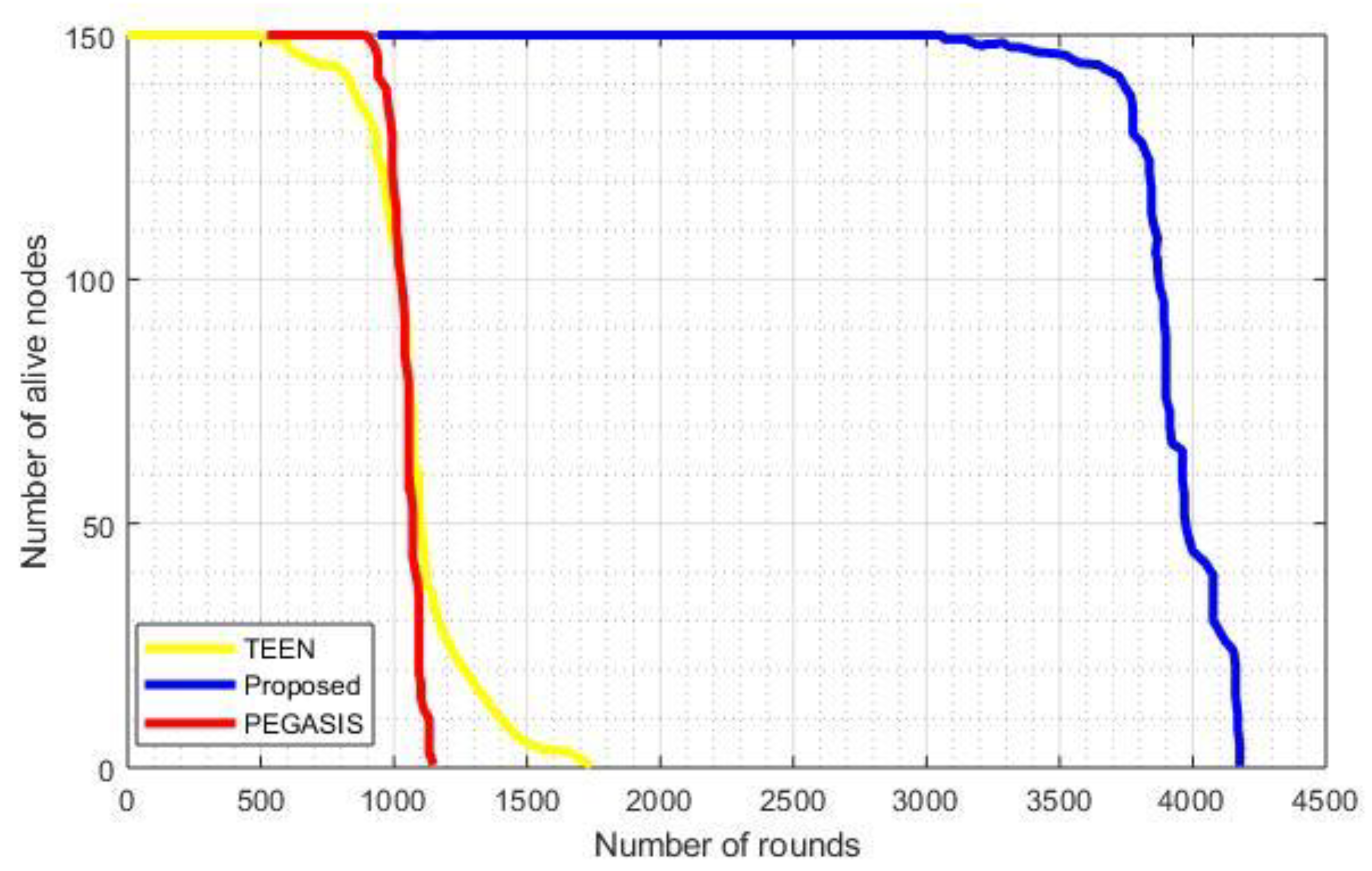



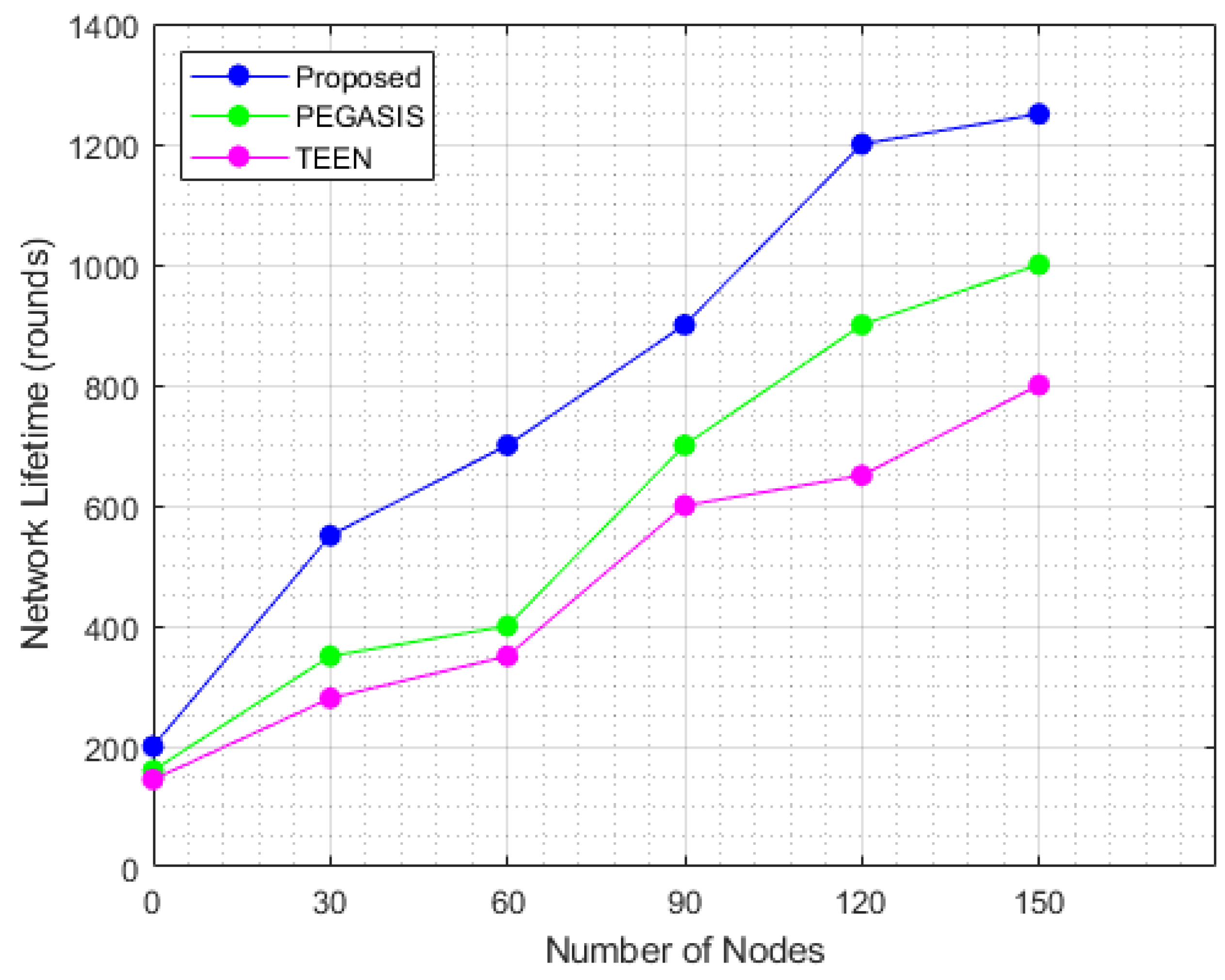

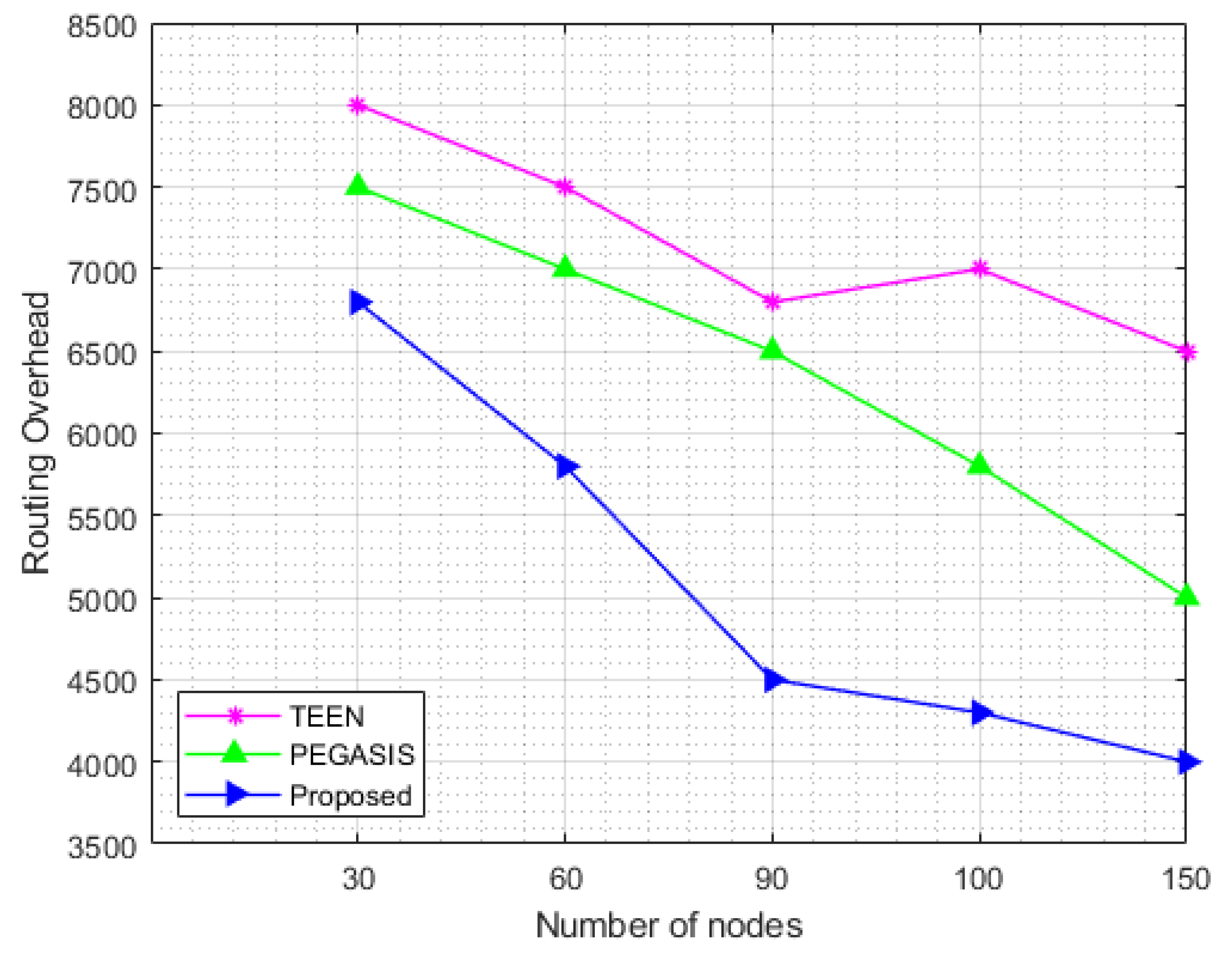
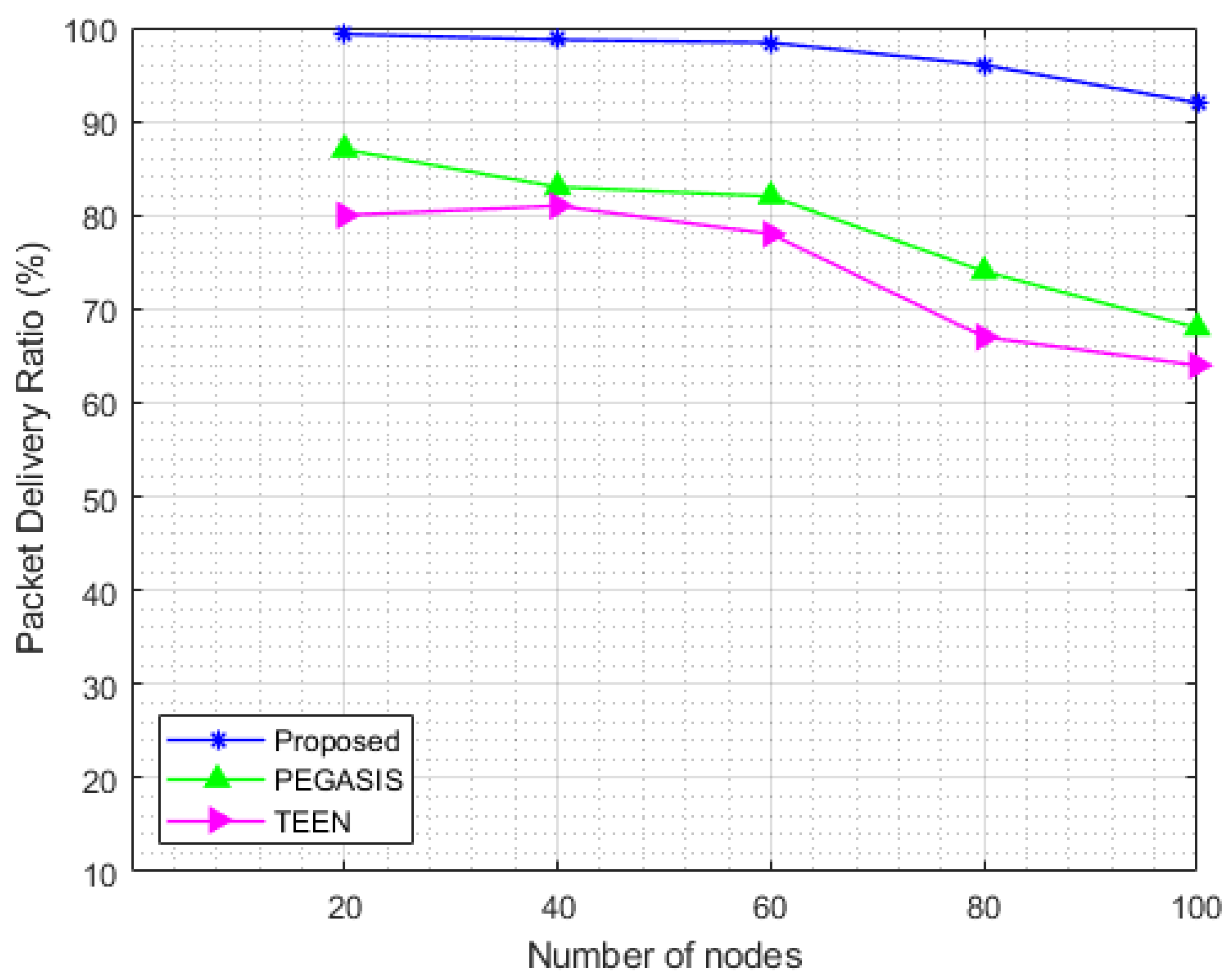
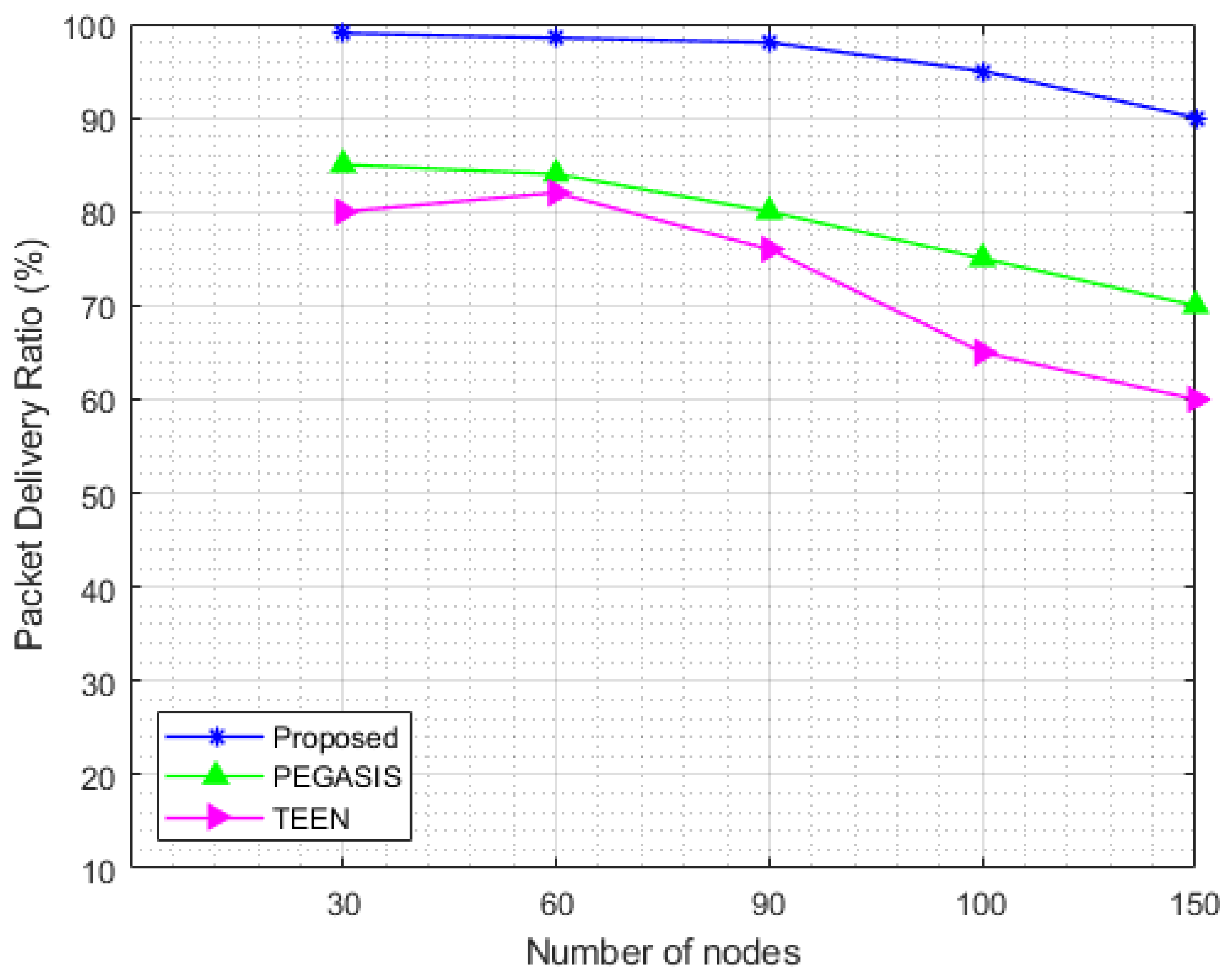
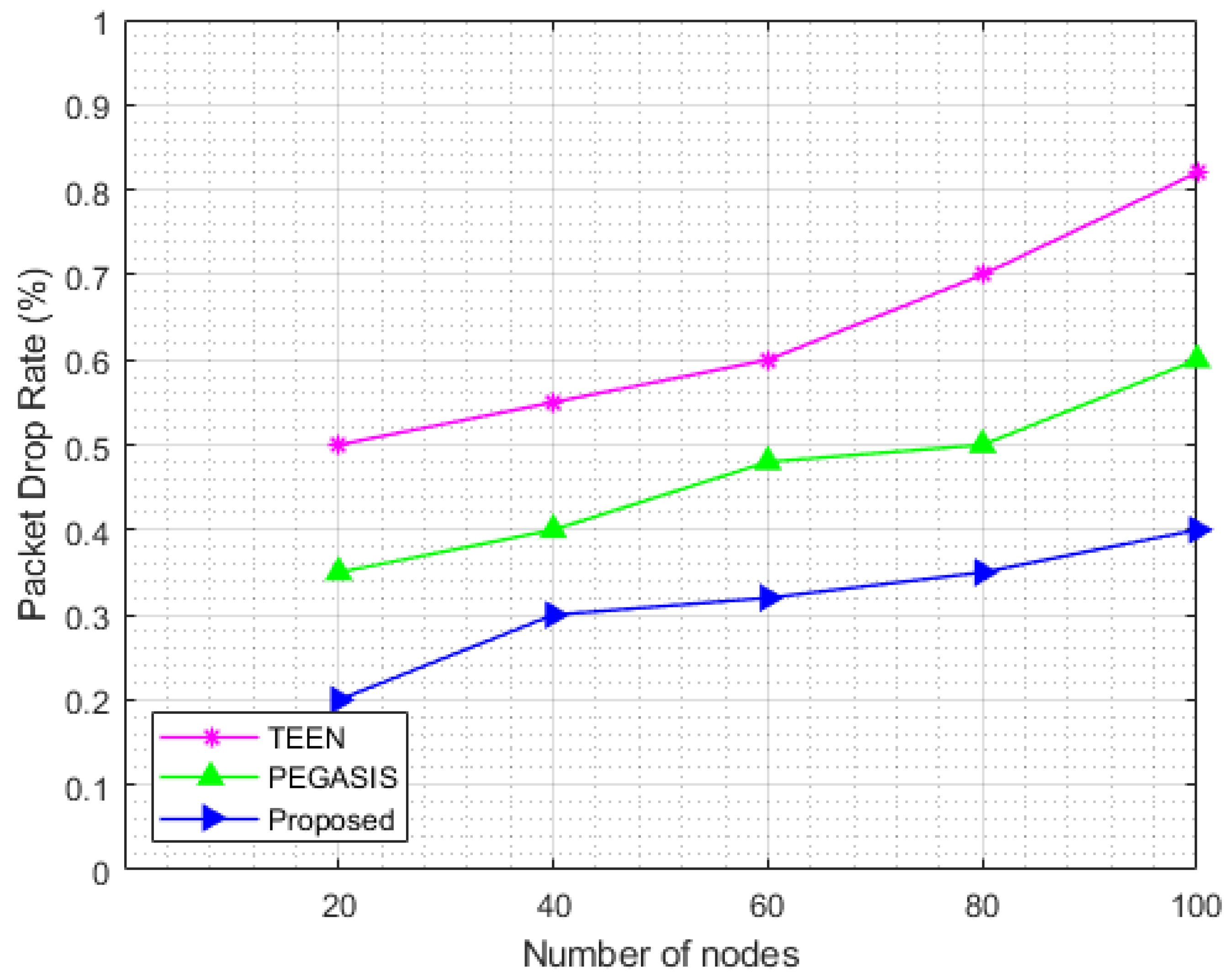
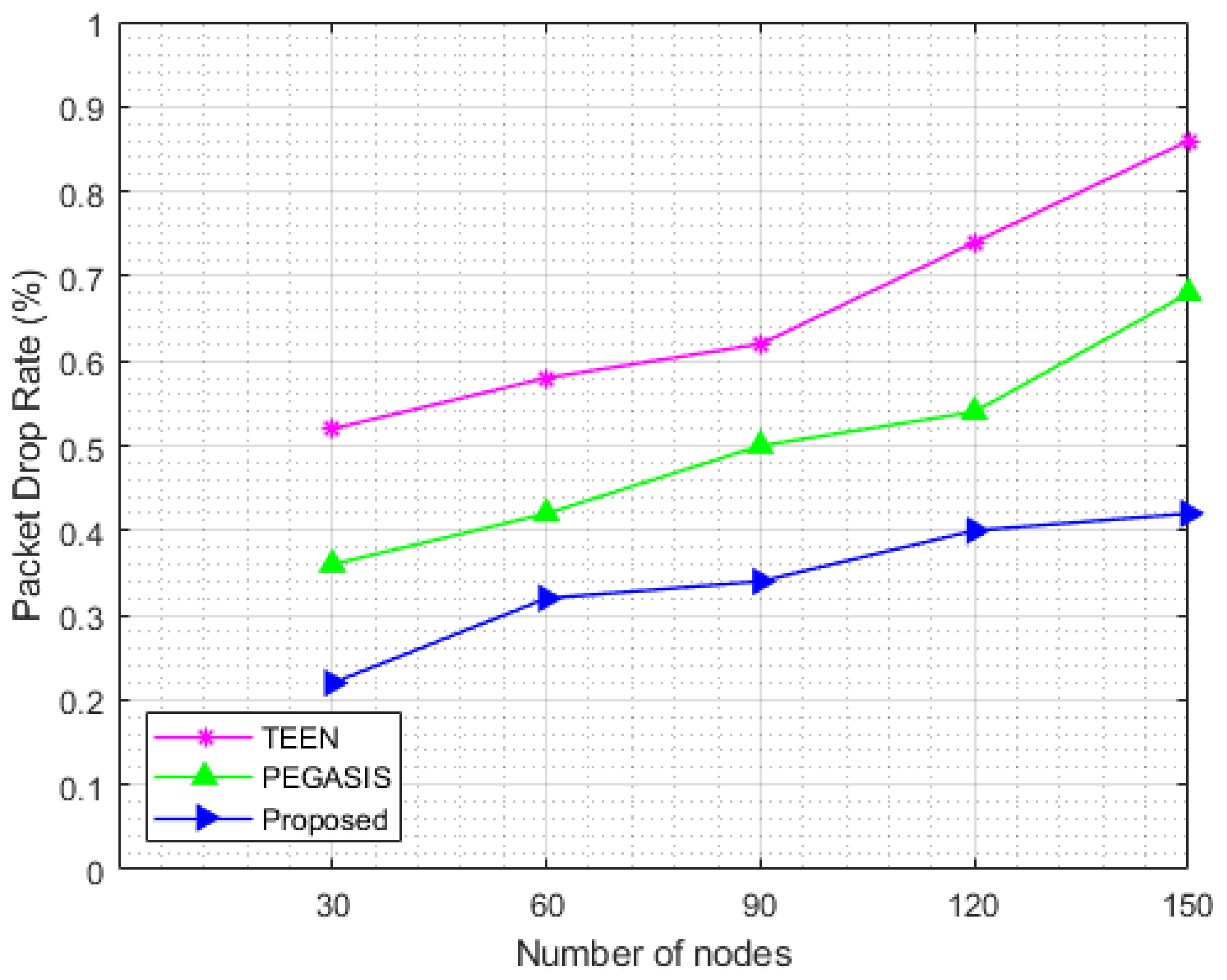
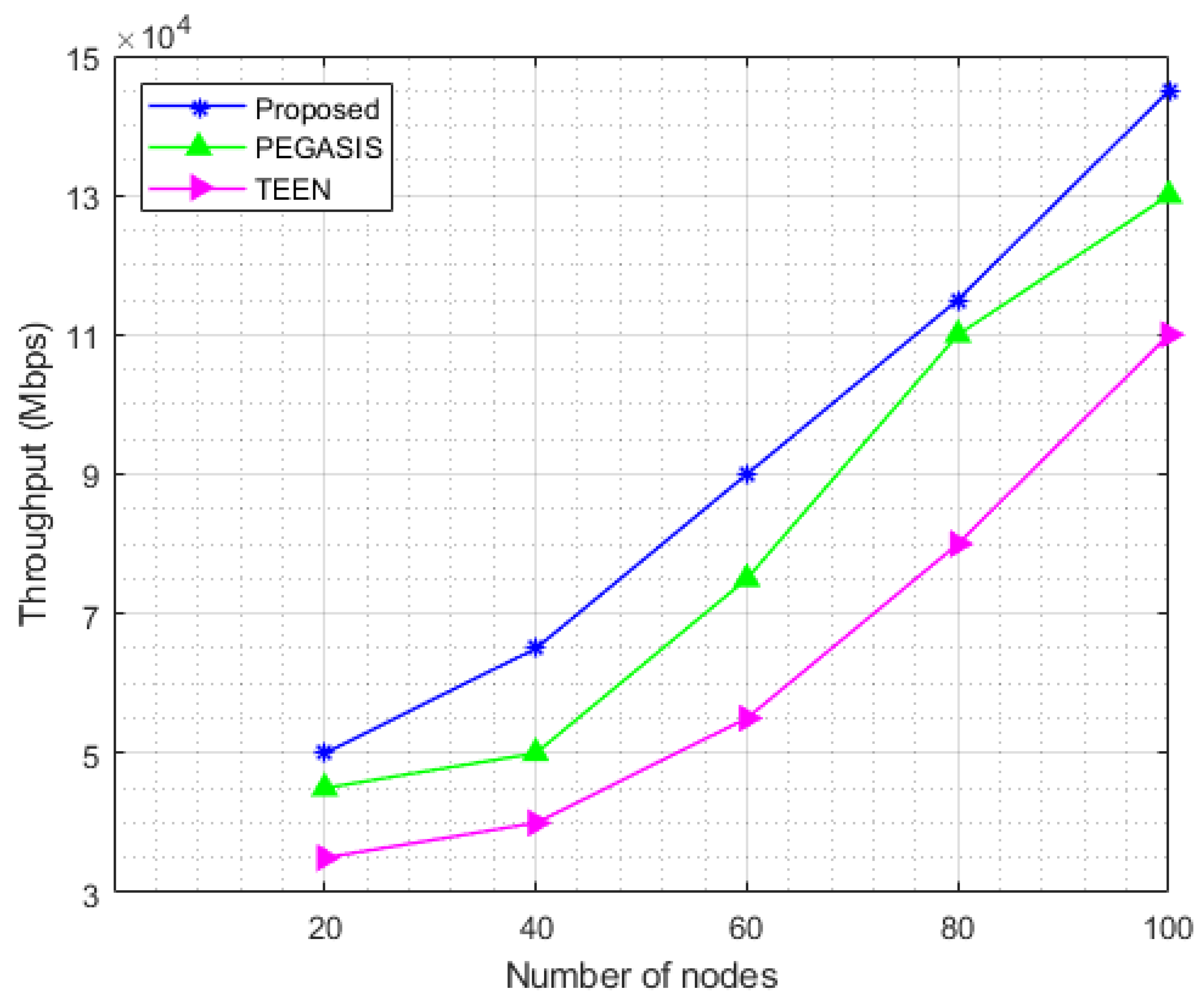

| Parameters | Value |
|---|---|
| Number of sensor nodes | 100 and 150 |
| Sensing range | 250 m × 250 m |
| Initial energy | 0.5 J |
| Base station | 1 |
| Packet size | 4000 bits |
| Number of CH | 4 |
| Number of the source node | 1 |
Publisher’s Note: MDPI stays neutral with regard to jurisdictional claims in published maps and institutional affiliations. |
© 2022 by the authors. Licensee MDPI, Basel, Switzerland. This article is an open access article distributed under the terms and conditions of the Creative Commons Attribution (CC BY) license (https://creativecommons.org/licenses/by/4.0/).
Share and Cite
Adumbabu, I.; Selvakumar, K. Energy Efficient Routing and Dynamic Cluster Head Selection Using Enhanced Optimization Algorithms for Wireless Sensor Networks. Energies 2022, 15, 8016. https://doi.org/10.3390/en15218016
Adumbabu I, Selvakumar K. Energy Efficient Routing and Dynamic Cluster Head Selection Using Enhanced Optimization Algorithms for Wireless Sensor Networks. Energies. 2022; 15(21):8016. https://doi.org/10.3390/en15218016
Chicago/Turabian StyleAdumbabu, I., and K. Selvakumar. 2022. "Energy Efficient Routing and Dynamic Cluster Head Selection Using Enhanced Optimization Algorithms for Wireless Sensor Networks" Energies 15, no. 21: 8016. https://doi.org/10.3390/en15218016
APA StyleAdumbabu, I., & Selvakumar, K. (2022). Energy Efficient Routing and Dynamic Cluster Head Selection Using Enhanced Optimization Algorithms for Wireless Sensor Networks. Energies, 15(21), 8016. https://doi.org/10.3390/en15218016








